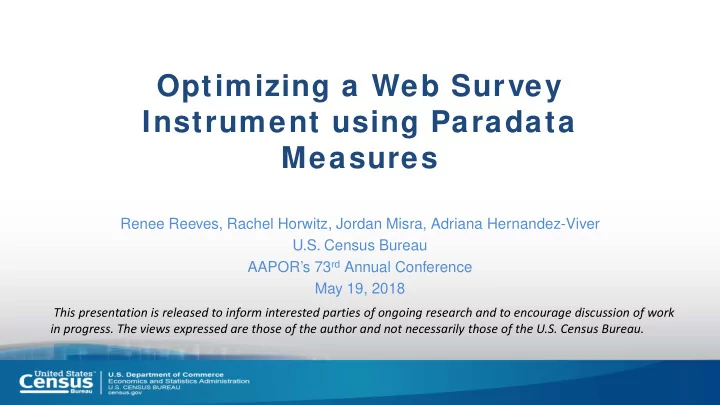

Optimizing a Web Survey Instrument using Paradata Measures Renee Reeves, Rachel Horwitz, Jordan Misra, Adriana Hernandez-Viver U.S. Census Bureau AAPOR’s 73 rd Annual Conference May 19, 2018 This presentation is released to inform interested parties of ongoing research and to encourage discussion of work in progress. The views expressed are those of the author and not necessarily those of the U.S. Census Bureau.
Paradata Data about a respondent’s interactions with the web instrument that are collected during the response process Captures each action the respondent makes Measures Completion times, breakoffs, error messages, previous clicks, and changed answers 2
Research Background Conducted research using paradata in prior survey cycles and provided recommendations Subset of the recommendations were implemented in 2017 3
Research Question/Methodology Did the changes to the web instrument successfully resolve the issues identified from the 2015 paradata analysis? Method: Nominally compare the problematic measures in 2015 to 2017 for screens with changes 4
The National Survey of College Graduates (NSCG) Longitudinal, biennial survey Two cohorts: new and returning Sponsored by the National Center for Science and Engineering Statistics within the National Science Foundation Data collection conducted by the U.S. Census Bureau Provides data about the characteristics of the college-educated workforce 5
Changes Implemented Removed introduction screen Eliminated follow-up screens for “Other” selection Simplified complex “Select all that apply” question Reduced the amount of contact information requested 6
Login/Introduction – 2015 High Breakoff Rate 7
Login/Introduction – 2017 8
Results - Overall Percentage of Respondents who Broke-off New Cohort Old Cohort 2015 7.7% 4.2% 2017 0.5% 1.0% Change -7.2% -3.2% 9
Results – First Screen Percentage of All Breakoffs on the First Screen New Cohort Old Cohort 2015 (Intro) 13.7% 15.0% 2017 (VerifyName) 1.4% 2.9% Change -12.3% -12.1% 10
Other, Specify – 2015 High - Previous Clicks - Completion Time 11
Other, Specify - 2017 12
Results - Overall Percentage of Respondents who Clicked Previous New Cohort Old Cohort 2015 68.2% 64.5% 2017 61.4% 52.4% Change -6.8% -12.1% 13
Results – Other, Specify Median Completion Times Old Cohort New Cohort 80 70 60 Seconds 50 40 30 20 10 0 2015 2017 2015 2017 Main Screen Other, Specify 14
Select all that apply in each column - 2015 High - Completion Time - Changed Answers 15
Select all that apply - 2017 16
Select all that apply - 2017 17
Results – Select all that apply Median Completion Times New Cohort Old Cohort 60 50 40 Seconds 30 20 10 0 2015 2017 2015 2017 Undergraduate Graduate 18
Results – Select all that apply Percent of Respondent Visits with a Changed Answer - 2017 Screen New Cohort Old Cohort Undergraduate 11.6% 13.0% Graduate 8.5% 6.5% 19
Contact Information – 2015 High - Completion Times - Error Messages 20
Contact Information – 2017 21
Results – Contact Information Median Completion Time 70 58 60 55 50 44 43 Seconds 40 30 20 10 0 New Old 2015 2017 22
Results – Contact Information Percent of All Error Messages 40 36 35 29 30 25 25 19 % 20 15 10 5 0 New Old 2015 2017 23
Takeaways/Further Research Overall reduction in completion times, previous clicks and breakoff rates Further Research: Complete remaining analysis of page-level measures for other screens with and without changes in 2017 Analysis of overall error rates and changed answer rates Monitor future cycles to evaluate instrument changes and identify additional issues 24
Thank You! Renee Reeves Survey Methodology Demographic Statistical Methods Division U.S. Census Bureau renee.reeves@census.gov 301-763-4679 25
Recommend
More recommend